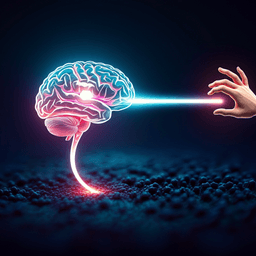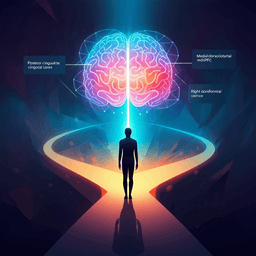
Medicine and Health
Neuronal responses in the human primary motor cortex coincide with the subjective onset of movement intention in brain-machine interface-mediated actions
J. Noel, M. Bockbrader, et al.
Using a unique BMI-NMES approach in a tetraplegic participant, this study reveals a novel form of intentional binding: intentions appear temporally attracted to actions, with evoked M1 spiking activity coinciding with the onset of subjective intention and co-varying trial-by-trial. Population-level decoder dynamics reflect intention-action binding. Research was conducted by Authors present in <Authors> tag.
~3 min • Beginner • English
Introduction
The study investigates how the subjective experience of intending to move relates temporally to neural activity in human primary motor cortex (M1), and how intention, action, and environmental effects interact in time. Prior work using the Libet task and intentional binding paradigms implicated frontoparietal areas (ACC, pre-SMA/SMA, parietal cortex) in initiating movements before awareness, but did not simultaneously examine intention, action, and effect, nor did it record cellular activity in humans during intentional binding, and largely overlooked M1. The authors hypothesize that M1 activity will reflect the onset of subjective intention and that the full intentional chain can reveal a novel temporal binding between intention and action. Using an intracortical BMI coupled with NMES in a tetraplegic participant, they test whether M1 spiking and population dynamics temporally align with reported intention and whether manipulating elements of the intentional chain modulates perceived timing.
Literature Review
Two classic paradigms frame the field: (1) the Libet task, showing readiness potential preceding reported intention, though interpretations are debated; and (2) intentional binding, where voluntary actions compress perceived time between action and effect. Prior invasive human studies found neurons in pre-SMA/SMA/ACC can anticipate subjective intention by ~0.7–1.5 s, and parietal stimulation can elicit movement intention. However, these studies typically omitted either intention measurement or environmental effects and did not probe human single-unit or multi-unit activity in M1 during intentional binding. The role of M1 in intention remains debated, with indirect evidence both for and against its involvement. This work targets the gap by recording M1 activity while independently manipulating intention, action, and effect.
Methodology
Design: Single-participant study with a 27-year-old male with chronic C5/C6 tetraplegia implanted with a 96-channel Utah array in left M1 (hand area). The participant used an intracortical BMI to decode movement intentions; decoded output triggered NMES to generate actual hand movements, enabling control and selective omission of intention, action, or effect.
Participant: Motor complete C5 with partial preservation to C6; expert BMI user (>5 years). Intact proprioception for shoulder/forearm and partial wrist; impaired finger proprioception.
Surgery and recording: Utah array (96 channels, 1.5 mm depth) implanted into hand area localized via pre-op fMRI and intraoperative navigation. Signals sampled at 30 kHz, hardware band-pass 0.3 Hz–7.5 kHz; NMES artifacts removed by blanking 3.5 ms around artifacts (>500 μV across ≥4 of 12 channels).
BMI decoder: Non-linear SVM using mean wavelet power (MWP) features (Daubechies scales 3–6; 235 Hz–3.75 kHz) in 100 ms bins across 96 channels, with sparsity optimization. Two classifiers (hand opening, HO; hand closing, HC) trained per session (~10 min), using imagined movements with a virtual hand. Decoder outputs ranged −1 to 1; movement threshold at zero-crossing. During experiments, HC was operant (linked to an effect), HO non-operant; decoder performance to evoke correct HC ~89.2% (0% HO when HC requested).
NMES: Forearm sleeve with 130 electrodes driven at 50 Hz, 500 μs pulses, 0–20 mA. Calibration per session (5–10 min) to evoke HO/HC.
Experimental paradigm: Clock-judgment task (clock hand cycle 2560 ms, randomized start). Trials belonged to blocks where one element of the intentional chain could be omitted: (i) full chain I→A→E (intention→action→effect, tone at 300 ms post-HC), (ii) no intention (A→E via NMES at random), (iii) no action (I→E, decoder threshold reached but NMES disabled; tone delivered at fixed delay), (iv) no effect (I→A, tone omitted), plus baseline blocks with random NMES-evoked HC or random tones without causal structure. After each trial, the participant reported the timing (0–60 clock ticks) of intention, action, or effect, as instructed.
Data acquisition and preprocessing:
- Multi-unit activity (MUA): Spikes convolved with 50 ms Gaussian; averaged per channel and condition. Evoked onset defined as >5 SD over baseline noise.
- Single units: Sessions concatenated and spike-sorted using WaveClust; units manually curated. Analyses focused primarily on first recording day to avoid duplicates (66 well-isolated units). Spike counts computed in sliding windows; correlations with subjective timing via Pearson’s r. Firing rate dynamics fit with logistic sigmoid per trial: f(t)=fi/(1+exp(-(t−t0)/α))+fb; parameters estimated; trials retained if r²>0.5.
- Population dynamics: PCA on averaged firing rates across 96 channels; first two PCs retained. Euclidean distances contrasted across conditions; bootstrap resampling (1000) for 95% CIs.
- LFP power: Wavelet decomposition (0.5–30 Hz); SVM (10-fold CV) used to classify induced vs baseline power; compared full chain vs missing intention/action/effect.
- Decoder analyses: Decoder output time-courses compared across conditions with time-resolved unpaired t-tests (Bonferroni). Area under the curve (AUC) of decoder used per trial; trials split into high vs low AUC tertiles to test relationships with reported times.
Behavioral/statistical analyses: Circular medians of reported times; non-parametric targeted tests. Temporal robustness assessed by perturbing reported times (±10 to ±1000 ms uniform) to evaluate degradation of evoked responses.
Ethics: FDA IDE and OSU IRB approvals; registered NCT01997125; informed consent; conducted per Declaration of Helsinki.
Key Findings
Behavioral intention–action binding:
- Overall perceptual bias: Actions and effects reported ~450–500 ms earlier than objective times (action: −455±21 ms; effect: −512±17 ms), yet relative action–effect interval was accurate and precise (median perceived difference 257 ms vs objective 300 ms; S.E.M. 17 ms).
- Variability: Intention reports more variable (S.E.M. 37.2 ms) than action (21.4 ms) or effect (17.2 ms).
- Full chain (I→A→E): Intention perceived to precede action by 71 ms; effect to follow action by 314 ms (error from objective: 14 ms), demonstrating intact relative timing.
- No intention (A→E via random NMES): Actions perceived later in time vs full chain (with intention: −526±44 ms; without intention: −355±18 ms; p=9.09×10⁻⁵).
- No action (I→E): Intention perceived earlier when action absent (with action: −597±79 ms; without action: −796±129 ms; p=0.02). Tone timing unaffected in both manipulations (p>0.1).
- No effect (I→A): Removing effect did not alter perceived times of intention (p=0.41) or action (p=0.07).
Conclusion: Novel intentional binding between intention and action (compression of perceived interval), distinct from classic action–effect binding.
MUA and subjective timing:
- Intention-only trials (no movement): Evoked MUA peak ~5–8 Hz at ~−338 ms relative to (would-be) movement onset.
- Movement-only trials: Evoked MUA peak ~20 Hz at ~+373 ms post movement onset.
- No evoked MUA to tones.
- Aligning MUA to subjective reports: Evoked onset occurred ~+14 ms after subjective intention time and ~+7 ms after subjective action time; responses robust to report-time perturbations up to ~±120 ms.
- Decoder-derived “objective” intention (first time decoder >5 SD above noise, ~70 ms before motor execution) did not align with evoked MUA; evoked activity coincided better with subjective intention.
Population dynamics (PCA/LFP):
- PCA (first two PCs) explained 81.9% variance; trajectories bifurcated with presence vs absence of intention; Euclidean distance peaked ~+300 ms post movement onset.
- LFP power: Intention associated with sustained low-frequency power (delta 0.5–4 Hz; theta 4–8 Hz; alpha 8–13 Hz). Differences between conditions (presence vs absence of intention) emerged at −1.09 s (delta), −0.98 s (theta), and −0.87 s (alpha) before movement; peaks at −290 ms (delta) and −210 ms (theta); movement strongest in alpha/beta, peaking ~+330 ms post movement.
Single-unit correlates:
- Of 66 well-isolated units (first day), 8/66 (12%) showed significant correlation between spike counts (−1000 ms window before movement) and subjective intention time (all p<0.05); 1/66 correlated with subjective action time; none with effect.
- Logistic fits of trial-level firing rates yielded mean t0 ~−108 ms (increase began ~108 ms before reported intention); α indicated relatively step-like changes (mean α≈23) compared to frontal areas in prior work (mean α≈54).
Decoder dynamics and binding:
- Decoder time-courses: Intended actions showed gradual early rise; NMES-evoked actions without intention showed delayed, abrupt rise. Bifurcation between intended vs unintended emerged ~−1100 ms before movement (p<0.01).
- Without action (I→E), decoder decayed earlier after threshold (p<0.01 at +100 ms). Without effect (I→A), decoder output remained elevated longer (p<0.01 at +500 ms).
- Decoder AUC and perceived times: High AUC trials led to intentions perceived later (closer to action) (p=3.77×10⁻⁴) and actions perceived earlier (p=0.01); effect timing unaffected (p=0.22). Indicates M1 population dynamics reflect intention–action binding.
Discussion
The study demonstrates that in a BMI-NMES framework enabling independent manipulation of intention, action, and effect, the subjective timing between intention and action compresses (intention–action binding). This extends intentional binding beyond physical event pairs (action–effect) to include internal states (intention) and overt actions. Neurally, M1 exhibits distinct signatures of intention and action: average evoked MUA coincides closely with the onset of subjective intention (within ~±120 ms) and follows subjective reports of action by ~7 ms, whereas the BMI decoder’s earlier “objective” detection of intention precedes motor execution but does not align with the evoked MUA peak. Population-level measures (PCA trajectories, low-frequency LFP power) indicate intention-related dynamics emerging up to ~1 s prior to movement, with strongest discriminability near movement onset, implying that preparatory intention signals are present in M1 but that subjective awareness of intention aligns more with the emergence of robust evoked spiking. Trial-by-trial, a subset of M1 neurons’ spike counts covary with the reported time of intention, and single-trial firing rate transitions occur on average ~108 ms before the reported urge, often in step-like fashion. Decoder behavior mirrors these findings: intended actions produce early gradual rises; removing action or effect alters post-threshold dynamics; decoder performance (AUC) predicts perceived temporal attraction between intention and action. Together, these results position M1 as reflecting the temporal onset of conscious intention more closely than upstream regions (ACC, pre-SMA/SMA), which show earlier anticipatory activity. The authors propose that intention may involve slow accumulation in upstream movement-null subspaces, with a near-instantaneous projection to movement-potent subspaces in M1 coinciding with the subjective experience of intention. This shifts emphasis from locating ever-earlier neural antecedents to anchoring subjective intention to specific M1 dynamics while acknowledging upstream origins.
Conclusion
This work introduces intention–action temporal binding and shows that human M1 activity marks the onset of the subjective experience of intending to move. Evoked MUA aligns within ~±120 ms of reported intention, some single neurons predict trial-by-trial intention timing, and M1 population dynamics/decoder outputs index and modulate perceived intention–action timing. These findings bridge a critical gap by relating M1 spiking to conscious intention timing and complement prior intracranial evidence from medial frontal and parietal areas. Future research should: (1) generalize behavioral and neural effects to neurotypical participants using non-invasive BMIs; (2) employ causal perturbations (e.g., stimulation) with concurrent recordings to dissect movement-null vs movement-potent subspaces; (3) record across multiple regions (ACC, SMA/pre-SMA, premotor, parietal, cerebellar-thalamocortical pathways) to map interregional dynamics underlying intention and its awareness; and (4) assess how long-term BMI use and neuroplasticity shape intention–action binding and M1 correlates.
Limitations
Single-participant case study of a tetraplegic expert BMI user limits generalizability; extensive BMI training and potential neuroplastic changes may bias perception (e.g., large anticipatory bias in action/effect timing) and neural signatures. Findings are correlational; no causal perturbations were applied. Subjective timing reports carry inherent temporal uncertainty, especially for intention, and onset definitions (e.g., evoked threshold at 5 SD) are somewhat arbitrary. Recordings were confined to M1; lack of simultaneous data from ACC/SMA/premotor/parietal precludes full network inference. The BMI decoder’s “objective” intention metric may not capture the same construct as subjective intention.
Related Publications
Explore these studies to deepen your understanding of the subject.







